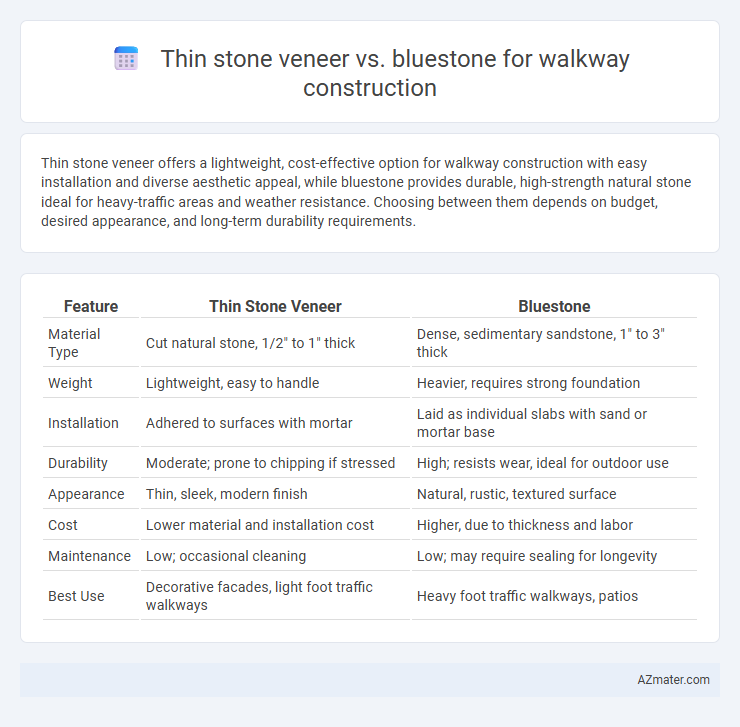Thin stone veneer offers a lightweight, cost-effective option for walkway construction with easy installation and diverse aesthetic appeal, while bluestone provides durable, high-strength natural stone ideal for heavy-traffic areas and weather resistance. Choosing between them depends on budget, desired appearance, and long-term durability requirements.
Table of Comparison
| Feature | Thin Stone Veneer | Bluestone |
|---|---|---|
| Material Type | Cut natural stone, 1/2" to 1" thick | Dense, sedimentary sandstone, 1" to 3" thick |
| Weight | Lightweight, easy to handle | Heavier, requires strong foundation |
| Installation | Adhered to surfaces with mortar | Laid as individual slabs with sand or mortar base |
| Durability | Moderate; prone to chipping if stressed | High; resists wear, ideal for outdoor use |
| Appearance | Thin, sleek, modern finish | Natural, rustic, textured surface |
| Cost | Lower material and installation cost | Higher, due to thickness and labor |
| Maintenance | Low; occasional cleaning | Low; may require sealing for longevity |
| Best Use | Decorative facades, light foot traffic walkways | Heavy foot traffic walkways, patios |
Overview: Thin Stone Veneer vs Bluestone Walkways
Thin stone veneer offers a lightweight, cost-effective alternative for walkway construction, providing the aesthetic of natural stone with easier installation. Bluestone, a dense, durable sandstone, is prized for its rich color variations and exceptional weather resistance, making it a long-lasting choice for outdoor paths. While thin stone veneer enhances design flexibility and reduces structural load, bluestone guarantees robust performance and authentic natural appeal in walkways.
Material Composition and Characteristics
Thin stone veneer consists of natural stone slices, typically 1 to 2 inches thick, offering a lightweight and easy-to-install option with high durability and resistance to weathering. Bluestone, a dense sandstone primarily composed of feldspar and quartz, features a fine-grained texture, natural slip resistance, and excellent strength, making it ideal for walkways with heavy foot traffic. While thin stone veneer prioritizes aesthetic versatility and reduced weight, bluestone emphasizes structural integrity and long-term performance in outdoor environments.
Installation Process and Requirements
Thin stone veneer offers a lightweight, easy-to-install solution for walkway construction, requiring a stable substrate, mortar application, and proper sealing to prevent moisture infiltration. Bluestone, a dense natural stone, demands more labor-intensive installation including a compacted base, precise leveling, and durable jointing materials to withstand outdoor conditions. Both materials necessitate skilled workmanship, but thin stone veneer typically reduces installation time and structural load compared to full-thickness bluestone slabs.
Durability and Weather Resistance
Thin stone veneer offers moderate durability and is suitable for walkways in areas with mild weather, but it may be prone to chipping and damage in harsh conditions. Bluestone is highly durable and exceptionally weather-resistant, making it ideal for walkways exposed to freeze-thaw cycles, heavy rain, and intense sunlight. Bluestone's dense composition and natural cleft surface provide superior longevity and slip resistance compared to thin stone veneer.
Aesthetic Appeal and Design Flexibility
Thin stone veneer offers high aesthetic appeal with its natural texture and uniform thickness, allowing seamless installation on various surfaces and enabling intricate patterns and designs. Bluestone provides a rich, earthy color palette and a rugged texture that enhances outdoor walkways with a timeless, rustic charm, while its natural variation adds unique character to each project. Both materials deliver excellent design flexibility, but thin stone veneer is particularly favored for custom shapes and multi-surface applications, whereas bluestone excels in traditional, durable paving.
Maintenance Needs and Longevity
Thin stone veneer offers a lightweight, cost-effective option for walkway construction with low maintenance needs, typically requiring occasional cleaning and resealing to prevent damage. Bluestone, known for its durability and natural resistance to weathering, demands less frequent upkeep but may need periodic sealing to maintain its color and prevent staining. Both materials provide long-lasting performance, though bluestone generally offers superior longevity due to its density and natural hardness.
Cost Comparison
Thin stone veneer generally offers a more cost-effective option for walkway construction due to lower material and installation expenses compared to bluestone. Bluestone, known for its durability and natural aesthetic, commands higher prices both in raw stone cost and labor-intensive installation. Budget-conscious projects often favor thin stone veneer to achieve a similar look while reducing overall investment.
Eco-Friendliness and Sustainability
Thin stone veneer offers a sustainable option for walkway construction by utilizing less natural stone material, reducing quarry impact, and minimizing transportation emissions due to its lightweight properties. Bluestone, known for its durability and natural composition, is eco-friendly when sourced responsibly from local quarries, reducing carbon footprint and supporting sustainable mining practices. Both materials promote environmental benefits, but thin stone veneer's efficiency in raw material use and installation energy makes it a greener choice for eco-conscious walkway projects.
Common Applications and Suitability
Thin stone veneer is commonly applied for decorative facades and light-duty walkways, offering aesthetic appeal with a thin profile that reduces structural load but may require a solid substrate for installation. Bluestone, known for its durability and natural slip resistance, is well-suited for high-traffic walkways, outdoor patios, and pool surrounds, providing a robust surface that withstands weathering and heavy use. Selecting between thin stone veneer and bluestone depends on the balance between desired appearance, load-bearing needs, and environmental exposure of the walkway.
Choosing the Best Option for Your Walkway
Thin stone veneer offers a lightweight, cost-effective alternative for achieving the natural beauty of stone in walkway construction, ideal for areas with structural load limits. Bluestone, known for its durability and slip-resistant surface, provides a robust option suited to high-traffic walkways requiring long-lasting performance. Choosing between thin stone veneer and bluestone depends on factors such as budget, structural support, aesthetic preference, and desired maintenance level for your walkway.

Infographic: Thin stone veneer vs Bluestone for Walkway construction
 azmater.com
azmater.com